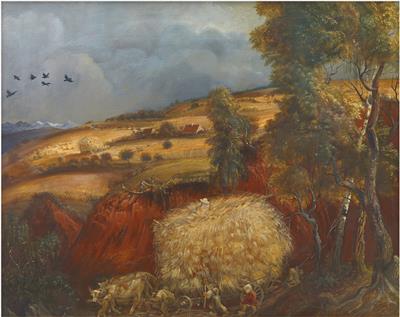Otto Dix *

(Gera 1891–1969 Singen) The harvest wagon, artist’s sign, dated 1941, oil and tempera on panel, 80 x 100 cm, framed, (PS)
Provenance: Private Collection, Germany
Literature: Fritz Löffler, Otto Dix, Werkverzeichnis der Gemälde, Recklinghausen 1981, no. 1941/14
As early as autumn 1933, Otto Dix withdrew into an ‘inner emigration’ at Lake Constance, concentrating during the war years on painting in glazes in the manner of the Old Masters. In doing so, he not only limited himself in technical terms, but also in respect of his subject matter, to the style of the Old Masters. Following Ruisdael and Altdorfer, for instance, Otto Dix here focuses his passion on what one might learn from a ‘harvest wagon’ about the relationship between man and nature. Much as in an Old Master painting, he conveys the landscape as overwhelming in relationship to the very small figures. ‘Dix’s landscapes are not representational images; instead they are concentrated and heighten reality. This was done on many levels: in the arrangement of details, in the omission of individual areas, in the emphasis on important elements and in eschewing the usual embedding of the scene within an encompassing environment, which had been so important to the Impressionists. Over the years, along with typical stylistic elements drawn from the masters of the Danube School, Dix also employed formal elements taken from the Baroque in his landscape painting. In this way, he layered the picture planes and represented the landscape from a partial bird’s eye view, by which he managed to give greater depth to his paintings.’ (...) “Fog, a rainbow, cloud masses, an evening mood, the solitude of winter; these are the characteristic themes of early Realism. Dix succeeds in creating his own style by using the techniques of the Old Masters of the 16th century, the discoveries made by the formal language of the Baroque and the atmospheric mood of the 19th century, which is yet in its vividness fully of the present day.’ (Fritz Löffler, Otto Dix, Leben und Werk, Wiesbaden 1960, pp. 103 and 105)
Expert: Dr. Petra Maria Schäpers
 Dr. Petra Maria Schäpers
Dr. Petra Maria Schäpers
+49 211 2107747
petra.schaepers@dorotheum.de
28.11.2013 - 18:00
- Dosažená cena: **
-
EUR 158.900,-
- Odhadní cena:
-
EUR 140.000,- do EUR 180.000,-
Otto Dix *
(Gera 1891–1969 Singen) The harvest wagon, artist’s sign, dated 1941, oil and tempera on panel, 80 x 100 cm, framed, (PS)
Provenance: Private Collection, Germany
Literature: Fritz Löffler, Otto Dix, Werkverzeichnis der Gemälde, Recklinghausen 1981, no. 1941/14
As early as autumn 1933, Otto Dix withdrew into an ‘inner emigration’ at Lake Constance, concentrating during the war years on painting in glazes in the manner of the Old Masters. In doing so, he not only limited himself in technical terms, but also in respect of his subject matter, to the style of the Old Masters. Following Ruisdael and Altdorfer, for instance, Otto Dix here focuses his passion on what one might learn from a ‘harvest wagon’ about the relationship between man and nature. Much as in an Old Master painting, he conveys the landscape as overwhelming in relationship to the very small figures. ‘Dix’s landscapes are not representational images; instead they are concentrated and heighten reality. This was done on many levels: in the arrangement of details, in the omission of individual areas, in the emphasis on important elements and in eschewing the usual embedding of the scene within an encompassing environment, which had been so important to the Impressionists. Over the years, along with typical stylistic elements drawn from the masters of the Danube School, Dix also employed formal elements taken from the Baroque in his landscape painting. In this way, he layered the picture planes and represented the landscape from a partial bird’s eye view, by which he managed to give greater depth to his paintings.’ (...) “Fog, a rainbow, cloud masses, an evening mood, the solitude of winter; these are the characteristic themes of early Realism. Dix succeeds in creating his own style by using the techniques of the Old Masters of the 16th century, the discoveries made by the formal language of the Baroque and the atmospheric mood of the 19th century, which is yet in its vividness fully of the present day.’ (Fritz Löffler, Otto Dix, Leben und Werk, Wiesbaden 1960, pp. 103 and 105)
Expert: Dr. Petra Maria Schäpers
 Dr. Petra Maria Schäpers
Dr. Petra Maria Schäpers
+49 211 2107747
petra.schaepers@dorotheum.de
|
Horká linka kupujících
Po-Pá: 10.00 - 17.00
kundendienst@dorotheum.at +43 1 515 60 200 |
| Aukce: | Moderní |
| Typ aukce: | Salónní aukce |
| Datum: | 28.11.2013 - 18:00 |
| Místo konání aukce: | Wien | Palais Dorotheum |
| Prohlídka: | 16.11. - 28.11.2013 |
** Kupní cena vč. poplatku kupujícího a DPH
Není již možné podávat příkazy ke koupi přes internet. Aukce se právě připravuje resp. byla již uskutečněna.
Všechny objekty umělce
